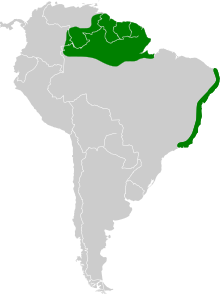Racket-tailed coquette
| Racket-tailed coquette | |
|---|---|

| |
| A male in Pernambuco, Brazil, spreading its tail | |
| Scientific classification | |
| Domain: | Eukaryota |
| Kingdom: | Animalia |
| Phylum: | Chordata |
| Class: | Aves |
| Clade: | Strisores |
| Order: | Apodiformes |
| Family: | Trochilidae |
| Genus: | Discosura |
| Species: | D. longicaudus
|
| Binomial name | |
| Discosura longicaudus (Gmelin, JF, 1788)
| |

| |
| Range of the racket-tailed coquette | |
| Synonyms[3] | |
|
Discosura longicauda (Gmelin, 1788) | |
The racket-tailed coquette (Discosura longicaudus; sometimes Discosura longicauda) is a species of hummingbird in the family Trochilidae native to northeastern South America.
Taxonomy[edit]
The racket-tailed coquette was formally described in 1788 by the German naturalist Johann Friedrich Gmelin in his revised and expanded edition of Carl Linnaeus's Systema Naturae. He placed it with all the other hummingbirds in the genus Trochilus and coined the binomial name Trochilus longicaudus.[4] Gmelin based his description on the "L'oiseau-mouche à raquettes" that had been described by the French polymath Georges-Louis Leclerc, Comte de Buffon in 1779 in his Histoire Naturelle des Oiseaux.[5] Buffon did not specify the origin of his specimen but in 1902 Hans von Berlepsch and Ernst Hartert designated the type locality as Cayenne, French Guiana.[6][7] The racket-tailed coquette is now placed with four other hummingbirds in the genus Discosura that was introduced in 1850 by the French naturalist Charles Lucien Bonaparte.[8][9] Formerly, ornithologists erroneously used the binomial name Discosura longicauda instead of Discosura longicaudus.[10] The genus name combines the Ancient Greek diskos meaning "plate" with oura meaning "tail". The specific epithet longicaudus combines the Latin longus meaning "long" and cauda meaning "tail".[11] The species is treated as monotypic: no subspecies are recognised.[9]

It is sometimes considered to be the only member of the genus Discosura, as the thorntails, the other possible members of the genus, are often placed in the genus Popelairia.[12][13]
Martin Johnson Heade depicted two coquettes in his painting Two Green-Breasted Hummingbirds (c. 1863), as part of his "Gems of Brazil".[14]
Description[edit]
The species weighs about 3.4 grams (0.12 oz) and is sexually dimorphic. The male is around 10.2 centimetres (4.0 in) long and has a distinctive brilliant green head and throat with a copper-coloured abdomen. The dark purple-brown tail is 5.1 centimetres (2.0 in) long, and forked, with two very long prongs, ending with a pair of round paddle- ("racket") shaped feathers. The female is shorter with a length of 6.9 centimetres (2.7 in). It has duller green upperparts and breast, black throat bordered by white and a white belly. Its tail is grey tipped with white,[15] and lacks "rackets".[16]
Distribution and habitat[edit]
The racket-tailed coquette generally is uncommon but it has a large distribution that is separated into two distinct parts: The largest is in the Guiana Shield of northern Brazil, French Guiana, Guyana, Suriname, and southern Venezuela. The other is in a strip along coastal eastern Brazil.[12] Its natural habitat is tropical moist lowland forests, as well as riparian forests.[13]
Behavior[edit]
Racket-tailed coquettes typically gather in the canopy of hapaxanth trees with other hummingbirds and steal other larger hummingbirds' nectar. They are consequently chased by the larger birds.[15]
They build their cup-sized nests out of soft plants and down 3–6 metres (9.8–19.7 ft) up a tree. Females usually have a clutch of two eggs, which are incubated for 13–14 days.[16]
References[edit]
- ^ BirdLife International (2016). "Discosura longicaudus". IUCN Red List of Threatened Species. 2016: e.T22687285A93146569. doi:10.2305/IUCN.UK.2016-3.RLTS.T22687285A93146569.en. Retrieved 11 November 2021.
- ^ "Appendices | CITES". cites.org. Retrieved 2022-01-14.
- ^ "Discosura longicaudus (Gmelin, 1788)". Colaboraciones Americanas Sobre Aves. Retrieved 23 February 2013.
- ^ Gmelin, Johann Friedrich (1788). Systema naturae per regna tria naturae : secundum classes, ordines, genera, species, cum characteribus, differentiis, synonymis, locis (in Latin). Vol. 1, Part 1 (13th ed.). Lipsiae [Leipzig]: Georg. Emanuel. Beer. p. 498.
- ^ Buffon, Georges-Louis Leclerc de (1779). "L'oiseau-mouche à raquettes". Histoire Naturelle des Oiseaux (in French). Vol. 6. Paris: De l'Imprimerie Royale. pp. 23–24.
- ^ Berlepsch, Hans von; Hartert, Ernst (1902). "On the birds of the Orinoco region". Novitates Zoologicae. 9: 1–135 [89].
- ^ Peters, James Lee, ed. (1945). Check-List of Birds of the World. Vol. 5. Cambridge, Massachusetts: Harvard University Press. p. 35.
- ^ Bonaparte, Charles Lucien (1850). Conspectus Generum Avium (in Latin). Vol. 1. Leiden: E.J. Brill. p. 84.
- ^ a b Gill, Frank; Donsker, David; Rasmussen, Pamela, eds. (January 2022). "Hummingbirds". IOC World Bird List Version 12.1. International Ornithologists' Union. Retrieved 12 July 2022.
- ^ David, Norman; Gosselin, Michel (2002). "Gender agreement of avian species names". Bulletin of the British Ornithologists' Club. 122 (1): 14–49 [37, No. 161, 47].
- ^ Jobling, James A. (2010). The Helm Dictionary of Scientific Bird Names. London: Christopher Helm. pp. 137, 229. ISBN 978-1-4081-2501-4.
- ^ a b "Racket-tailed Coquette (Discosura longicauda)". The Internet Bird Collection. Retrieved 21 February 2013.
- ^ a b Sedgwick, Carolyn W. (2011). T. S. Schulenberg (ed.). "Discosura longicaudus". Neotropical Birds. Cornell Lab of Ornithology. Retrieved 26 February 2013.
- ^ Theodore E. Jr., Stebbins; Comey, Janet L.; Quinn, Karen E. (2000). The Life and Work of Martin Johnson Heade: A Critical Analysis and Catalogue Raisonné. Yale University Press. p. 71. ISBN 978-0-300-08183-1. Retrieved 25 February 2013.
- ^ a b Hilty, Steven L. (2002). Birds of Venezuela. Princeton University Press. p. 408. ISBN 1400834090.
- ^ a b "Racket-tailed Coquette (Discosura longicaudus)". Planetofbirds.com. 8 May 2011. Retrieved 26 February 2013.

